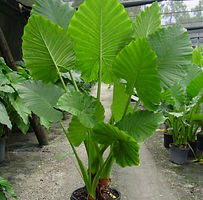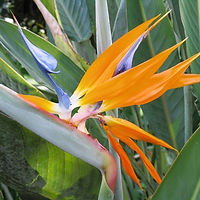CARE INSTRUCTIONS
TROPICALS
Go Directly to:
Please Note: All Tropicals will need to be kept in a heated (60+ degrees) and sunny location. This is necessary from early November until danger of last frost has passed, early spring. Thanks!
_JPG.jpg)
Colocasia - Thai Giant
The Thai Giant elephant ear is one of the most popular tropical's available. It's large, heart shaped leaves can reach 4 feet wide and 6 feet long during the growing season. This make's it an ideal candidate for the garden focal point or to fill in a larger open space. The Blue-green leaves make for an outstanding specimen. Easy care and rapid growth makes this an all around favorite.
Cultivation
For containers, plant using an 80/20 Peat to Perlite ratio. In ground planting may require a simple soil test. Amend your ground soil using peat based products that will help the soil retain moisture. Starter plants need to be kept warm during winter months. Plant out in early spring after danger of last frost has passed.
This variety is shade tolerant, but will do best in medium to full sun. Plant height at maturity: 6-10 feet tall. Frequent water and food will insure rapid growth. Feed 16-10-10 (or close). USDA Hardiness Zones 8-10
Height:
Water:
Fertilizer:
Sun:
8-10
6-10', Smaller in Container
2-4 times weekly in the growing season (March to August)
16-10-10
Full or filtered sun, partial shade

Alocasia - Calidora
Alocasia Calidora Elephant Ear or Persian Palm. Has very large, rounded, green leaves with an upright growth habit. Each leaf may reach up to 3? across. The wavy-edged leaves are held high on thick green stems. Calidora makes a great addition to any landscape and gives it an instant tropical look.
Cultivation
For containers, plant using an 80/20 Peat to Perlite ratio. In ground planting may require a simple soil test. Amend your ground soil using peat based products that will help the soil retain moisture. Starter plants need to be kept warm during winter months. Plant out in early spring after danger of last frost has passed. This variety is shade tolerant, making it an ideal houseplant. It does equally well outdoors in full sun. Outdoor height of 6-7' with spacing 4-6'. Grown primarily for foliage.
7-9+
Height:
Water:
Fertilizer:
Sun:
6-7', Smaller in Container
1-2 times weekly in the growing season (March to August)
16-10-10
Full Sun
Alocasia - Portora

This hybrid of Alocasia ordora and Alocasia portei, makes a stunning upright clump. The giant green leaves are held upright by strong purple stalks. This is an architectural specimen plant for any garden. 'Portora' needs to have rich moist organic soil for optimal growth. A thick layer of winter mulch helps to prevent rot in cold wet soils. (New nomenclature w/ correct name is Alocasia 'Portora', previous listed as: Alocasia 'Portidora')
Cultivation
This variety will do well in partial shade or full sun. Requires regular watering, Outdoor height of 5-6' tall with 3' spread. Can be container grown. Repot in rich, well-draining soil. Zone 7b-11 and higher. Soil test
7b-11
Height:
Water:
Fertilizer:
Sun:
8-10', Smaller in Container
2-4 times weekly in the growing season (March to August)
16-2-12 or 16-10-10
Full Sun
Bird of Paradise - Strelitzia Reginae

Bird-of-paradise or crane flower (Strelitzia reginae) is a native of South Africa and is closely related to the banana. The herbaceous plant derives its common names from the unique flower it bears, which resembles a brightly colored bird in flight. The leathery leaves are held upright on stiff leafstalks and are about 6 inches wide and 18 inches long. The plant forms a 3- to 5-foot-tall clump that can be used as a focal point in the landscape or in mass plantings. The evergreen leaves of bird-of-paradise do not drop from the plant, which makes it an excellent addition around pools or wherever shedding leaves are an aesthetic and/or maintenance problem. In colder climates, Bird of Paradise can be used as a house plant.
Cultivation
The plant will tolerate temperatures as low as 24°F for a short time; however, freezing temperatures will damage developing flower buds and flowers. Does best in moist, well-draining soil. Flowers and foliage slightly larger in partial shade. Space 6' apart. Soil pH 5.5-7.5; Zone 9-12. In ground planting may require a simple soil test. Amend your ground soil using peat based products that will help the soil retain moisture.